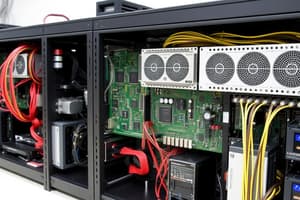Podcast
Questions and Answers
Компьютердің «миды» атқаратын бөлігі қайсы?
Компьютердің «миды» атқаратын бөлігі қайсы?
- Аналық плата
- Тасымалдағыш құрылғылар
- Орталық өңдеу блогы (CPU) (correct)
- Жедел жады (RAM)
Жергілікті желі (LAN) таңдаған жағдайда, ол не істейді?
Жергілікті желі (LAN) таңдаған жағдайда, ол не істейді?
- Географиялық аймақтағы құрылғыларды байланыстырады (correct)
- Қолданбалы бағдарламалар жасау
- Деректерді интернет арқылы жібереді
- Деректер базаларын басқару
Қайсысы деректердің қауіпсіздігін қамтамасыз етеді?
Қайсысы деректердің қауіпсіздігін қамтамасыз етеді?
- Авторланбаған қол жеткізуден қорғау (correct)
- Деректерді резервтеу және қалпына келтіру
- Деректердің тұтастығы
- Деректерді сақтаудың дұрыс форматы
Қайсысы бағдарламалық қамтаманың түрі емес?
Қайсысы бағдарламалық қамтаманың түрі емес?
Бұлтты компьютерлеудің анықтамасы қандай?
Бұлтты компьютерлеудің анықтамасы қандай?
E-commerce не үшін қолданылады?
E-commerce не үшін қолданылады?
CRM жүйелерінің негізгі функциясы қандай?
CRM жүйелерінің негізгі функциясы қандай?
AI және ML технологияларының негізгі мақсаты неде?
AI және ML технологияларының негізгі мақсаты неде?
Мобильді есептеудің болашақтағы рөлі қандай?
Мобильді есептеудің болашақтағы рөлі қандай?
Киберқауіпсіздік жүйелері несіз болмайды?
Киберқауіпсіздік жүйелері несіз болмайды?
Flashcards
Орталық өңдеу блогы (ОӨБ)
Орталық өңдеу блогы (ОӨБ)
Компьютердің «миы», нұсқауларды орындауға жауап береді.
Жады (RAM)
Жады (RAM)
ОӨБ-нің ағымдағы пайдаланып жатқан деректері мен нұсқаулары үшін уақытша сақтау орны.
Сақтау құрылғылары
Сақтау құрылғылары
Деректерді сақтау үшін пайдаланылатын құрылғылар, мысалы, қатқыл дискілер, SSD-лер.
Желі
Желі
Signup and view all the flashcards
Бұлтты есептеу
Бұлтты есептеу
Signup and view all the flashcards
Электрондық сауда (E-commerce)
Электрондық сауда (E-commerce)
Signup and view all the flashcards
Кәсіпорын ресурстарын жоспарлау (ERP)
Кәсіпорын ресурстарын жоспарлау (ERP)
Signup and view all the flashcards
Тұтынушылармен қарым-қатынас басқару (CRM)
Тұтынушылармен қарым-қатынас басқару (CRM)
Signup and view all the flashcards
Әлеуметтік медианы басқару
Әлеуметтік медианы басқару
Signup and view all the flashcards
Киберқауіпсіздік
Киберқауіпсіздік
Signup and view all the flashcards
Study Notes
Introduction to IT
- Information Technology (IT) encompasses all aspects of computing, data storage, and communication.
- It includes hardware, software, networks, and data.
- IT systems are used for diverse purposes, from personal use to large-scale business operations.
- IT continuously evolves, with new technologies and applications emerging regularly.
Hardware Components
- Central Processing Unit (CPU): The "brain" of a computer, responsible for executing instructions.
- Memory (RAM): Temporary storage for data and instructions currently being used by the CPU.
- Storage Devices (e.g., hard drives, SSDs): Permanent storage for data.
- Input Devices (e.g., keyboard, mouse, scanner): Used to input data into the computer system.
- Output Devices (e.g., monitor, printer): Display or communicate output from the computer system.
- Motherboard: The main circuit board in a computer connecting all components.
Software Components
- Operating Systems (e.g., Windows, macOS, Linux): Manage computer hardware and software resources.
- Applications Software: Programs for specific tasks (e.g., word processing, spreadsheets, web browsers).
- Programming Languages: Used to develop software applications.
- Databases: Organize and manage large amounts of data.
- Middleware: Connects different software applications and systems.
Networking Concepts
- Network: A collection of interconnected devices enabling communication and resource sharing.
- Local Area Network (LAN): Connects devices within a limited geographic area (e.g., home, office).
- Wide Area Network (WAN): Connects devices across a larger geographic area (e.g., internet).
- Internet: A global network connecting millions of computers worldwide.
- Protocols: Rules governing data transmission across networks (e.g., TCP/IP).
- Cloud Computing: Storing and accessing data and software over the internet.
Data Management
- Data Storage: Managing and saving data in various formats.
- Data Security: Protecting data from unauthorized access, modification, or destruction.
- Data Integrity: Ensuring data accuracy and consistency.
- Data Backup and Recovery: Creating data copies and restoring them in case of loss.
- Data Analysis: Extracting insights from large amounts of data.
- Database Management Systems (DBMS): Software applications for managing databases.
IT Applications
- E-commerce: Conducting business transactions online.
- Enterprise Resource Planning (ERP): Integrating business processes into a single system.
- Customer Relationship Management (CRM): Managing customer interactions and data.
- Social Media Management: Maintaining and managing a company's social media presence.
- Cybersecurity: Protecting computer systems and networks from cyber threats.
- Artificial Intelligence (AI) and Machine Learning (ML): Using algorithms for complex tasks and data analysis.
Future Trends in IT
- Artificial intelligence: Automation and intelligent systems will continue growing.
- Cloud computing: Cloud services will become more integrated and widespread.
- Internet of Things (IoT): More devices will connect to the internet.
- Data analytics and big data: Businesses will rely more on data-driven insights.
- Cybersecurity: Threats and vulnerabilities will continually evolve, requiring advanced security measures.
- Mobile computing: The mobile-first approach will remain dominant.
Studying That Suits You
Use AI to generate personalized quizzes and flashcards to suit your learning preferences.
Description
Ақпараттық технологиялар (IT) компьютерлер, деректерді сақтау және коммуникацияның барлық аспектілерімен айналысады. Бұл аппараттық және бағдарламалық компоненттерден, желілер мен деректерден тұрады. IT жүйелері жеке қолданудан бастап, ірі бизнес операцияларына дейін әртүрлі мақсатта пайдаланылады.




